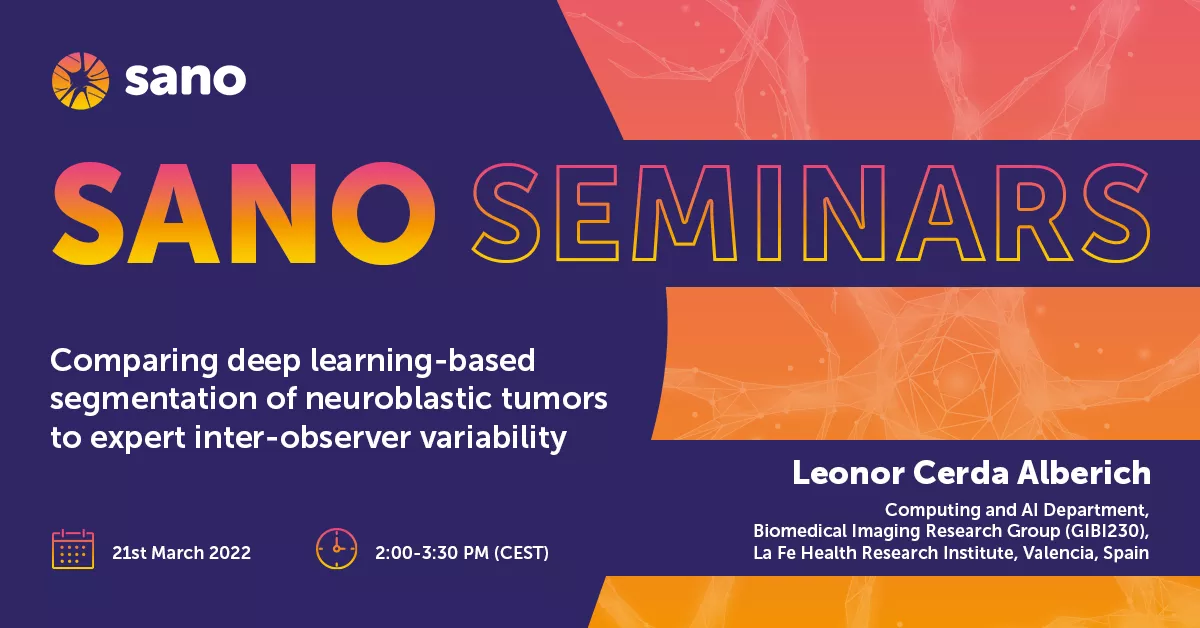
56. Comparing deep learning-based segmentation of neuroblastic tumors to expert inter-observer variability
Leonor Cerda Alberich – Computing and AI Department, Biomedical Imaging Research Group (GIBI230), La Fe Health Research Institute, Valencia, Spain
Abstract
Volumetric segmentation of intrinsically heterogeneous neuroblastic tumours is essential for the diagnosis, follow-up and treatment response evaluation of neuroblastoma cancer. Manual segmentation of neuroblastic tumours is a tedious and time-consuming task that hinders the radiologists’ workflow. Different studies have explored the development of semi-automatic segmentation algorithms in CT images, making use of mathematical morphology, fuzzy connectivity, and other image processing tools. Nevertheless, they are performed with a very low number of cases and the findings show little improvement with respect to manual approaches.
As of today, a robust and generalizable solution does not exist for neuroblastoma. In this study, we are exploring the nnU-Net framework as an automated solution based on convolutional neural networks (CNNs) for segmentation of neuroblastic tumours on magnetic resonance imaging (MRI) for the extraction of reproducible quantitative imaging biomarkers and the prediction of relevant clinical outcomes associated to neuroblastoma cancer. In addition, novel metrics are proposed for a better evaluation of image segmentation tasks, and reproducibility studies are also performed for the estimation of interobserver variability on manual segmentation.
PRIMAGE
This study is performed within the scope of the PRIMAGE project. Financed by the European Commission, PRIMAGE has 16 European partners that are participating in the consortium and has an implementation duration of 4 years. Internationally recognized researches in in-silico technologies and clinical experts in pediatric cancer are part of the staff of PRIMAGE
This project proposes an open cloud-based platform to support decision making in the clinical management of two paediatric cancers, Neuroblastoma (NB), the most frequent solid cancer of early childhood, and the Diffuse Intrinsic Pontine Glioma (DIPG) the leading cause of brain tumour-related death in children.
PRIMAGE platform implements the latest advancement of in-silico imaging biomarkers and modelling of tumour growth towards a personalised diagnosis, prognosis and therapies follow-up.
About the author
Leonor Cerdá Alberich, Doctor in Physics. Her career began in 2013 at the Institute for Corpuscular Physics (IFIC, University of Valencia – CSIC), working on the analysis of large unstructured data sets collected with the ATLAS experiment at the European Organization for Nuclear Research (CERN), where she obtained her doctorate Cum Laude in Physics in 2018. She has extensive experience in data analysis, image modelling with artificial intelligence, development of image standardization algorithms, extraction of quantitative parameters, automatic segmentation, data acquisition, technical management, tutoring and outreach.
She currently works as head of the Computing and AI Department within the Biomedical Imaging Research Group (GIBI230) at the La Fe Health Research Institute. She leads and performs tasks such as biomedical image processing and development of artificial intelligence algorithms and methodologies for the extraction of image biomarkers and prediction of relevant clinical outcomes. Her main research lines include harmonization of imaging data, obtention of radiogenomic signatures, heterogeneity studies based on the identification of tumor habitats, and development of novel methodologies for feature selection, dimensionality reduction and prediction of clinical endpoints.

